A Review of the Current State of Technology of Capacitive Wireless Power Transfer
Abstract
:1. Introduction
1.1. Motivation
- It allows for an improved user experience and convenience, in particular towards portable consumer electronics. It removes the hassle of connecting wires to the device.
- A WPT device does not need an open connector for charging. This allows for an entirely sealed (water and dust proof) device, increasing robustness and durability.
- Moreover, since a large charging connector is no longer necessary and battery size can be reduced, miniaturization is facilitated.
- WPT can also increase safety. Indeed, galvanic charging can generate sparks when (dis)connecting which can cause safety issues, in particular in hazardous industrial environments where combustible gasses are present.
- Mobile devices (such as smartphones, laptops or electric vehicles) function independent of the electric grid due to internal batteries. However, they regularly loose their mobility when they have to be connected for recharging. WPT would allow charging during the use of the device, e.g., an electric car can charge when driving on a highway [1] or smartphones could be charged at the office, even when they are in the pocket of the user [2]. In this way, mobility is improved.
- Wireless charging infrastructure is not abundant and requires a significant implementation cost.
- Compared to galvanic charging, WPT is less efficient.
- Safety and electromagnetic interference (EMI) should be accounted for. Often, more excess heat is produced, which can put strain on the components selection.
- WPT is generally more expensive than galvanic charging.
- WPT is limited to lower power exchange limits.
- The varying magnetic field induces eddy currents which results in power losses, temperature rise and fire hazards.
- The magnetic fields easily radiate outside the WPT system, increasing EMI problems.
- For large coils (e.g., dynamic charging of electric vehicles), the conductive losses in the coils are significant, decreasing efficiency.
- IPT often requires litz wire to reduce the skin effect and ferrites to guide the magnetic fields. Both increase the weight, cost, and fragility of the system.
- The power transfer quickly drops when the coils are misaligned.
- Coils can be bulky, in particular for miniaturized integrated circuit applications.
- The power losses due to eddy current are minimal.
- CPT is able to transfer power wirelessly through isolated metal objects.
- Contrary to IPT, some misalignment does not lower the power transfer significantly
- The coupling is realized by simple conductive plates (e.g., aluminum or copper), which are less expensive and heavy than litz wire coils. This simple setup also facilitates a high reliability and long lifetime compared to IPT. Moreover, no special shape is required, allowing for a versatile design.
- CPT is less voluminous than IPT, allowing its implementation into integrated circuits.
- Usually, less heat is produced compared to IPT with its high resistance windings of coils.
- The electric field lines of the CPT coupling are narrowers than the magnetic field lines in an IPT system. As a result, the EMI will usually be lower for short distance power transfer.
- It allows for a simple configuration for charging multiple receivers from a single transmitter.
- The low capacitance (and thus high impedance and low power density) of the capacitive coupling, which we will discuss further in detail.
- High frequencies and voltages are necessary, in particular for bridging larger distances. This imposes high requirements on the converter components.
- A high electric field between the primary and secondary side imposes strict safety regulation, e.g., object detection between the plates.
1.2. Literature Review
1.3. Contribution and Paper Organization
- Providing a holistic overview on CPT modelling
- Taking multi-plate structures, compensation circuits and power electronic converters into account.
- Providing recommendations for the choice of CPT structures based on the application.
- Summarizing challenges, limitations and further improvements.
2. Capacitive Coupling Model
2.1. Pi-Model
2.2. Two-Port Network
3. Plate Structures
3.1. Two-Plate Structure
3.2. Four-Plate Structure
3.3. Six-Plate Structure
3.4. Matrix Structure
3.5. Concentric Structure
3.6. Electric Field Repeater
4. Compensation Networks
4.1. L Compensation
- non-resonance (N-N)
- primary resonance (S-N)
- secondary resonance (N-S)
- series-series (S-S)
- series-parallel (S-P)
4.2. LC Compensation
4.3. Multistage L-Section Networks
- Current or voltage gain;
- Load impedance characteristic;
- Input impedance characteristic.
4.4. Other Compensation Topologies
5. Converters
- Pulse width modulation (PWM);
- Power amplified based converter;
- Full-bridge inverter.
5.1. PWM Based Converter
5.2. Power Amplifier Based Converter
5.3. Full-Bridge Inverter
6. Challenges
6.1. CPT at Variable Loads
6.2. Transfer Medium
6.3. Safety Issues
7. Discussion
- Implementation area: based on this, safety area restrictions can be imposed. For example, an installation with people in the vincinity will require a narrow safety area and will therefore prefer a six-plate structure, whereas a fully automated warehouse can provide a large safety area where a four-plate structure suffices.
- Output power: goes along with the choice of inverter type. Higher power rating, above 1 kW, generally demands a full-bridge inverter.
- Distance between transmitter and receiver: This parameter affects the choices of the inverter type and compensation circuits. For distances greater than 10 cm, multistage L-section networks are preferred.
8. Conclusions
Author Contributions
Funding
Institutional Review Board Statement
Informed Consent Statement
Data Availability Statement
Conflicts of Interest
Abbreviations
| GPT | Galvanic power transfer |
| WPT | Wireless power transfer |
| IPT | Inductive power transfer |
| CPT | Capacitive power transfer |
| EMI | Electromagnetic interference |
| EM | Electromagnetic |
| PWM | Pulse width modulation |
| MOSFET | Metal-oxide-semiconductor field-effect-transistor |
| ZVS | Zero-voltage-switching |
| D | Diode |
| S | Switch |
| C | Coupling capacitance [F] |
| L | Inductance [H] |
| q | Electric Charge [C] |
| I | Current [A] |
| V | Voltage [A] |
| Angular velocity [rad/s] | |
| Q | Quality factor |
| kE | Capacitive coupling coefficient |
| N-N | Non-resonance |
| S-N | Primary-resonance |
| N-S | Secondary-resonance |
| S-S | series-series |
| S-P | series-parallel |
References
- Zhang, H.; Lu, F.; Mi, C. An electric roadway system leveraging dynamic capacitive wireless charging: Furthering the continuous charging of electric vehicles. IEEE Electrif. Mag. 2020, 8, 52–60. [Google Scholar] [CrossRef]
- Jadidian, J.; Katabi, D. Magnetic MIMO: How to charge your phone in your pocket. In Proceedings of the 20th Annual International Conference on Mobile Computing and Networking, Maui, HI, USA, 7–11 September 2014; pp. 495–506. [Google Scholar]
- Haerinia, M.; Shadid, R. Wireless power transfer approaches for medical implants: A Review. Signals 2020, 1, 209–229. [Google Scholar] [CrossRef]
- Jegadeesan, R.; Agarwal, K.; Guo, Y.X.; Yen, S.C.; Thakor, N.V. Wireless power delivery to flexible subcutaneous implants using capacitive coupling. IEEE Trans. Microw. Theory Tech. 2016, 65, 280–292. [Google Scholar] [CrossRef]
- Minnaert, B.; Thoen, B.; Plets, D.; Joseph, W.; Stevens, N. Wireless energy transfer by means of inductive coupling for dairy cow health monitoring. Comput. Electron. Agric. 2018, 152, 101–108. [Google Scholar] [CrossRef] [Green Version]
- Lu, X.; Wang, P.; Niyato, D.; Kim, D.I.; Han, Z. Wireless Charging Technologies: Fundamentals, Standards, and Network Applications. IEEE Commun. Surv. Tutor. 2016, 18, 1413–1452. [Google Scholar] [CrossRef] [Green Version]
- Covic, G.A.; Boys, J.T. Inductive power transfer. Proc. IEEE 2013, 101, 1276–1289. [Google Scholar] [CrossRef]
- Minnaert, B.; Mongiardo, M.; Costanzo, A.; Mastri, F. Maximum efficiency solution for capacitive wireless power transfer with N receivers. Wirel. Power Transf. 2020, 7, 65–75. [Google Scholar] [CrossRef]
- Jawad, A.M.; Nordin, R.; Gharghan, S.K.; Jawad, H.M.; Ismail, M. Opportunities and challenges for near-field wireless power transfer: A review. Energies 2017, 10, 1022. [Google Scholar] [CrossRef]
- Dai, J.; Ludois, D.C. A Survey of Wireless Power Transfer and a Critical Comparison of Inductive and Capacitive Coupling for Small Gap Applications. IEEE Trans. Power Electron. 2015, 30, 6017–6029. [Google Scholar] [CrossRef]
- Kithany, D. Wireless Power Market Tracker—Q4 2019—Omdia. Available online: https://omdia.tech.informa.com/OM005496/Wireless-Power-Market-Tracker—Q4-2019 (accessed on 12 April 2021).
- Tesla, N. Experiments with Alternate Currents of Very High Frequency and their Application to Methods of Artificial Illumination. Trans. Am. Inst. Electr. Eng. 1891, 266–319. [Google Scholar] [CrossRef]
- Khazraj, H.; Faria Da Silva, F.; Bak, C.L.; Hajibashi, M. Electromagnetic Interference Issues of a Wireless Power Transmission Converter. In Proceedings of the 2018 IEEE International Conference on Environment and Electrical Engineering and 2018 IEEE Industrial and Commercial Power Systems Europe (EEEIC / I&CPS Europe), Palermo, Italy, 12–15 June 2018; pp. 6–11. [Google Scholar] [CrossRef]
- Yu, X.; Skauli, T.; Skauli, B.; Sandhu, S.; Catrysse, P.B.; Fan, S. Wireless power transfer in the presence of metallic plates: Experimental results. AIP Adv. 2013, 3, 062102. [Google Scholar] [CrossRef]
- Magnetics, A. Litz Wire: An Ideal Solution for High-Frequency Applications. Available online: https://www.agilemagco.com/blog/5-benefits-of-using-litz-wire/ (accessed on 17 May 2021).
- Batra, T.; Schaltz, E.; Ahn, S. Effect of ferrite addition above the base ferrite on the coupling factor of wireless power transfer for vehicle applications. J. Appl. Phys. 2015, 117, 4–8. [Google Scholar] [CrossRef]
- Sun, L.; Ma, D.; Tang, H. A review of recent trends in wireless power transfer technology and its applications in electric vehicle wireless charging. Renew. Sustain. Energy Rev. 2018, 91, 490–503. [Google Scholar] [CrossRef]
- Tamura, M.; Naka, Y.; Murai, K.; Nakata, T. Design of a Capacitive Wireless Power Transfer System for Operation in Fresh Water. IEEE Trans. Microw. Theory Tech. 2018, 66, 5873–5884. [Google Scholar] [CrossRef]
- Miyazaki, M.; Abe, S.; Suzuki, Y.; Sakai, N.; Ohira, T.; Sugino, M. Sandwiched parallel plate capacitive coupler for wireless power transfer tolerant of electrode displacement. In Proceedings of the 2017 IEEE MTT-S International Conference on Microwaves for Intelligent Mobility (ICMIM), Nagoya, Japan, 19–21 March 2017; pp. 29–32. [Google Scholar] [CrossRef]
- Lu, F.; Zhang, H.; Mi, C. A review on the recent development of capacitive wireless power transfer technology. Energies 2017, 10, 1752. [Google Scholar] [CrossRef] [Green Version]
- Komaru, T.; Akita, H. Positional characteristics of capacitive power transfer as a resonance coupling system. In Proceedings of the 2013 IEEE Wireless Power Transfer (WPT), Perugia, Italy, 15–16 May 2013; pp. 218–221. [Google Scholar] [CrossRef]
- Karabulut, A.; Bilic, H.G.; Ozdemir, S. Capacitive Power Transfer Theory and the Overview of its Potential. In Proceedings of the 3rd International Mediterranean Science and Engineering Congress, Adana, Turkey, 24–26 October 2018. [Google Scholar]
- Minnaert, B.; Stevens, N. Optimal analytical solution for a capacitive wireless power transfer system with one transmitter and two receivers. Energies 2017, 10, 1444. [Google Scholar] [CrossRef] [Green Version]
- Rozario, D.; Azeez, N.A.; Williamson, S.S. Comprehensive review and comparative analysis of compensation networks for Capacitive Power Transfer systems. IEEE Int. Symp. Ind. Electron. 2016, 823–829. [Google Scholar] [CrossRef]
- Kumar, A.; Pervaiz, S.; Chang, C.K.; Korhummel, S.; Popovic, Z.; Afridi, K.K. Investigation of power transfer density enhancement in large air-gap capacitive wireless power transfer systems. In Proceedings of the 2015 IEEE Wireless Power Transfer Conference (WPTC), Boulder, CO, USA, 13–15 May 2015. [Google Scholar] [CrossRef]
- Park, C.; Lee, S.W.; Taek Rim, C. 5m-off-long-distance inductive power transfer system using optimum shaped dipole coils. In Proceedings of the 7th International Power Electronics and Motion Control Conference, Harbin, China, 2–5 June 2012; Volume 2, pp. 1137–1142. [Google Scholar] [CrossRef]
- Pries, J.; Galigekere, V.P.N.; Onar, O.C.; Su, G.J. A 50-kW Three-Phase Wireless Power Transfer System Using Bipolar Windings and Series Resonant Networks for Rotating Magnetic Fields. IEEE Trans. Power Electron. 2020, 35, 4500–4517. [Google Scholar] [CrossRef]
- Lu, F.; Zhang, H.; Hofmann, H.; Mi, C.C. A Double-Sided LC-Compensation Circuit for Loosely Coupled Capacitive Power Transfer. IEEE Trans. Power Electron. 2018, 33, 1633–1643. [Google Scholar] [CrossRef]
- Kline, M.; Izyumin, I.; Boser, B.; Sanders, S. Capacitive power transfer for contactless charging. In Proceedings of the 2011 Twenty-Sixth Annual IEEE Applied Power Electronics Conference and Exposition (APEC), Fort Worth, TX, USA, 6–11 March 2011; pp. 1398–1404. [Google Scholar] [CrossRef] [Green Version]
- Sarin, A.; Abbot, D.; Revzen, S.; Avestruz, A.T. Bidirectional Capacitive Wireless Power Transfer for Energy Balancing in Modular Robots. In Proceedings of the 2020 IEEE Applied Power Electronics Conference and Exposition (APEC), New Orleans, LA, USA, 15–19 March 2020; pp. 852–859. [Google Scholar] [CrossRef]
- Wang, K.; Sanders, S. Contactless USB—A capacitive power and bidirectional data transfer system. In Proceedings of the 2014 IEEE Applied Power Electronics Conference and Exposition—APEC 2014, Fort Worth, TX, USA, 16–20 March 2014; pp. 1342–1347. [Google Scholar] [CrossRef]
- Shmilovitz, D.; Ozeri, S.; Ehsani, M.M. A resonant LED driver with capacitive power transfer. In Proceedings of the 2014 IEEE Applied Power Electronics Conference and Exposition—APEC 2014, Fort Worth, TX, USA, 16–20 March 2014; pp. 1384–1387. [Google Scholar] [CrossRef]
- Hu, A.P.; Liu, C.; Li, H.L. A novel contactless battery charging system for soccer playing robot. In Proceedings of the 2008 15th International Conference on Mechatronics and Machine Vision in Practice, Auckland, New Zealand, 2–4 December 2008; pp. 646–650. [Google Scholar] [CrossRef]
- Park, C.; Park, J.; Shin, Y.; Kim, J.; Huh, S.; Kim, D.; Park, S.; Ahn, S. Separated Circular Capacitive Coupler for Reducing Cross-Coupling Capacitance in Drone Wireless Power Transfer System. IEEE Trans. Microw. Theory Tech. 2020, 68, 3978–3985. [Google Scholar] [CrossRef]
- Yu, G.Q.; Gao, Z.; Liu, N. Design of Capacitive Wireless Power Transmission System in Seawater. DEStech Trans. Environ. Energy Earth Sci. 2020. [Google Scholar] [CrossRef] [Green Version]
- Li, S.; Liu, Z.; Zhao, H.; Zhu, L.; Shuai, C.; Chen, Z. Wireless Power Transfer by Electric Field Resonance and Its Application in Dynamic Charging. IEEE Trans. Ind. Electron. 2016, 63, 6602–6612. [Google Scholar] [CrossRef]
- Liang, J.; Wu, D.; Yu, J. A Design Method of Compensation Circuit for High-Power Dynamic Capacitive Power Transfer System Considering Coupler Voltage Distribution for railway applications. Electronics 2021, 10, 153. [Google Scholar] [CrossRef]
- Li, C.; Zhao, X.; Liao, C.; Wang, L. A graphical analysis on compensation designs of large-gap CPT systems for EV charging applications. CES Trans. Electr. Mach. Syst. 2018, 2, 232–242. [Google Scholar] [CrossRef]
- Lu, F.; Zhang, H.; Mi, C. A Two-Plate Capacitive Wireless Power Transfer System for Electric Vehicle Charging Applications. IEEE Trans. Power Electron. 2018, 33, 964–969. [Google Scholar] [CrossRef]
- Vu, V.B.; Kamal, L.B.M.; Tay, J.; Pickert, V.; Dahidah, M.; Logenthiran, T.; Phan, V.T. A multi-output capacitive charger for electric vehicles. IEEE Int. Symp. Ind. Electron. 2017, 565–569. [Google Scholar] [CrossRef]
- Lu, F.; Zhang, H.; Hofmann, H.; Mi, C. A CLLC-compensated high power and large air-gap capacitive power transfer system for electric vehicle charging applications. In Proceedings of the 2016 IEEE Applied Power Electronics Conference and Exposition (APEC), Long Beach, CA, USA, 20–24 March 2016; pp. 1721–1725. [Google Scholar] [CrossRef]
- Triviño, A.; González-González, J.M.; Aguado, J.A. Wireless Power Transfer Technologies Applied to Electric Vehicles: A Review. Energies 2021, 14, 1547. [Google Scholar] [CrossRef]
- Kodeeswaran, S.; Nandhini Gayathri, M. Performance investigation of capacitive wireless charging topologies for electric vehicles. In Proceedings of the 2021 International Conference on Innovative Trends in Information Technology (ICITIIT), Kottayam, India, 11–12 February 2021. [Google Scholar] [CrossRef]
- Moon, J. High-frequency capacitive wireless power transfer technologies. J. Power Electron. 2021. [Google Scholar] [CrossRef]
- Zhang, H.; Lu, F.; Hofmann, H.; Liu, W.; Mi, C.C. A Four-Plate Compact Capacitive Coupler Design and LCL-Compensated Topology for Capacitive Power Transfer in Electric Vehicle Charging Application. IEEE Trans. Power Electron. 2016, 31, 8541–8551. [Google Scholar] [CrossRef]
- Zhang, H.; Lu, F.; Hofmann, H.; Liu, W.; Mi, C. A large air-gap capacitive power transfer system with a 4-plate capacitive coupler structure for electric vehicle charging applications. In Proceedings of the 2016 IEEE Applied Power Electronics Conference and Exposition (APEC), Long Beach, CA, USA, 20–24 March 2016; pp. 1726–1730. [Google Scholar] [CrossRef]
- Muharam, A.; Ahmad, S.; Hattori, R.; Hapid, A. 13.56 MHz scalable shielded-capacitive power transfer for electric vehicle wireless charging. In Proceedings of the 2020 IEEE PELS Workshop on Emerging Technologies: Wireless Power Transfer (WoW), Seoul, Korea, 15–19 November 2020; pp. 298–303. [Google Scholar] [CrossRef]
- Liu, C.; Hu, A.P.; Dai, X. A contactless power transfer system with capacitively coupled matrix pad. In Proceedings of the 2011 IEEE Energy Conversion Congress and Exposition, Phoenix, AZ, USA, 17–22 September 2011; pp. 3488–3494. [Google Scholar] [CrossRef]
- Zhang, H.; Lu, F.; Hofmann, H.; Mi, C. An LC compensated electric field repeater for long distance capacitive power transfer. In Proceedings of the 2016 IEEE Energy Conversion Congress and Exposition (ECCE), Milwaukee, WI, USA, 18–22 September 2016; pp. 5–9. [Google Scholar] [CrossRef]
- Zhang, H.; Lu, F.; Hofmann, H.; Liu, W.; Mi, C.C. Six-Plate Capacitive Coupler to Reduce Electric Field Emission in Large Air-Gap Capacitive Power Transfer. IEEE Trans. Power Electron. 2018, 33, 665–675. [Google Scholar] [CrossRef]
- Yang, L.; Ju, M.; Zhang, B. Bidirectional Undersea Capacitive Wireless Power Transfer System. IEEE Access 2019, 7, 121046–121054. [Google Scholar] [CrossRef]
- Siddique, N.I.; Abdullah, S.M.; Nafees, Q.; Islam, U. A Comprehensive Overview on the Development of Compensation Topologies for Capacitive Power Transfer System. Electr. Electron. Eng. 2019, 9, 9–16. [Google Scholar] [CrossRef]
- Liu, C.; Hu, A.P.; Budhia, M. A generalized coupling model for Capacitive Power Transfer systems. IECON Proc. 2010, 274–279. [Google Scholar] [CrossRef]
- Huang, L.; Hu, A.P. Defining the mutual coupling of capacitive power transfer for wireless power transfer. Electron. Lett. 2015, 51, 1806–1807. [Google Scholar] [CrossRef]
- Ahmad, S.; Hattori, R.; Muharam, A. Generalized Circuit Model of Shielded Capacitive Power Transfer. Energies 2021, 14, 2826. [Google Scholar] [CrossRef]
- Lawson, W.; Mayergoyz, I. Basic Electric Circuit Theory; Elsevier: London, UK, 1997. [Google Scholar]
- Zhu, Q.; Zang, S.; Zou, L.J.; Zhang, G.; Su, M.; Hu, A.P. Study of coupling configurations of capacitive power transfer system with four metal plates. Wirel. Power Transf. 2019, 97–112. [Google Scholar] [CrossRef]
- Liu, C.; Hu, A.P.; Wang, B.; Nair, N.K.C. A capacitively coupled contactless matrix charging platform with soft switched transformer control. IEEE Trans. Ind. Electron. 2013, 60, 249–260. [Google Scholar] [CrossRef]
- Zou, L.J.; Hu, A.P.; Su, Y.G. A single-wire capacitive power transfer system with large coupling alignment tolerance. In Proceedings of the 2017 IEEE PELS Workshop on Emerging Technologies: Wireless Power Transfer (WoW), Chongqing, China, 20–22 May 2017; pp. 93–98. [Google Scholar] [CrossRef]
- IEEE. IEEE Approved Draft Standard for Safety Levels with Respect to Human Exposure to Electric, Magnetic and Electromagnetic Fields, 0 Hz to 300 GHz; IEEE PC95.1-2019/Cor 1-2019/D2; IEEE: Piscataway, NJ, USA, 2020; pp. 1–39. [Google Scholar]
- Reatti, A.; Pugi, L.; Corti, F.; Grasso, F. Effect of Misalignment in a Four Plates Capacitive Wireless Power Transfer System. In Proceedings of the 2020 IEEE International Conference on Environment and Electrical Engineering and 2020 IEEE Industrial and Commercial Power Systems Europe (EEEIC/I&CPS Europe), Madrid, Spain, 9–12 June 2020; pp. 1–4. [Google Scholar] [CrossRef]
- Muharam, A.; Ahmad, S.; Hattori, R. Scaling-factor and design guidelines for shielded-capacitive power transfer. Energies 2020, 13, 4240. [Google Scholar] [CrossRef]
- Al-Saadi, M.; Al-Bahrani, L.; Al-Qaisi, M.; Al-Chlaihawi, S.; Crăciunescu, A. Capacitive power transfer for wireless batteries charging. Electroteh. Electron. Autom. 2018, 66, 40–51. [Google Scholar]
- Dai, J.; Ludois, D.C. Biologically inspired coupling pixilation for position independence in capacitive power transfer surfaces. In Proceedings of the 2015 IEEE Applied Power Electronics Conference and Exposition (APEC), Charlotte, NC, USA, 15–19 March 2015; pp. 3276–3282. [Google Scholar] [CrossRef]
- Liu, C.; Hu, A.P.; Nair, N.K.C. Coupling study of a rotary capacitive power transfer system. In Proceedings of the 2009 IEEE International Conference on Industrial Technology, Churchill, VIC, Australia, 10–13 February 2009; pp. 27–32. [Google Scholar] [CrossRef]
- Ludois, D.C.; Reed, J.K.; Hanson, K. Capacitive power transfer for rotor field current in synchronous machines. IEEE Trans. Power Electron. 2012, 27, 4638–4645. [Google Scholar] [CrossRef]
- Ludois, D.C.; Erickson, M.J.; Reed, J.K. Aerodynamic fluid bearings for translational and rotating capacitors in noncontact capacitive power transfer systems. IEEE Trans. Ind. Appl. 2014, 50, 1025–1033. [Google Scholar] [CrossRef]
- Rouse, C.D.; Cove, S.R.; Salami, Y.; Arsenault, P.; Bartlett, A. Three-phase Resonant Capacitive Power Transfer for Rotary Applications. IEEE J. Emerg. Sel. Top. Power Electron. 2020, 6777, 1. [Google Scholar] [CrossRef]
- Minnaert, B.; Monti, G.; Costanzo, A.; Mongiardo, M. Gain expressions for capacitive wireless power transfer with one electric field repeater. Electronics 2021, 10, 723. [Google Scholar] [CrossRef]
- Liu, C.; Hu, A.P.; Covic, G.A.; Nair, N.K.C. Comparative study of CCPT systems with two different inductor tuning positions. IEEE Trans. Power Electron. 2012, 27, 294–306. [Google Scholar] [CrossRef]
- Kuroda, S.; Imura, T. Derivation and comparison of efficiency and power in non-resonant and resonant circuit of capacitive power transfer. In Proceedings of the 2020 IEEE PELS Workshop on Emerging Technologies: Wireless Power Transfer (WoW), Seoul, Korea, 15–19 November 2020; pp. 152–157. [Google Scholar] [CrossRef]
- Kumar, A.; Sinha, S.; Sepahvand, A.; Afridi, K.K. Improved Design Optimization for High-Efficiency Matching Networks. IEEE Trans. Power Electron. 2018, 33, 37–50. [Google Scholar] [CrossRef]
- Sinha, S.; Kumar, A.; Regensburger, B.; Afridi, K.K. Design of High-Efficiency Matching Networks for Capacitive Wireless Power Transfer Systems. IEEE J. Emerg. Sel. Top. Power Electron. 2020, 1. [Google Scholar] [CrossRef]
- Sinha, S.; Kumar, A.; Afridi, K.K. Improved design optimization of efficient matching networks for capacitive wireless power transfer systems. In Proceedings of the 2018 IEEE Applied Power Electronics Conference and Exposition (APEC), San Antonio, TX, USA, 4–8 March 2018; pp. 3167–3173. [Google Scholar] [CrossRef]
- Yehui, H.; Perreault, D.J. Analysis and design of high efficiency matching networks. IEEE Trans. Power Electron. 2006, 21, 1484–1491. [Google Scholar] [CrossRef]
- Rozario, D. Design of Contactless Capacitive Power Transfer Systems for Battery Charging Applications. Master’s Thesis, University of Ontario Institute of Technology, Ontario, CA, USA, 2016; pp. 1–115. [Google Scholar]
- Ning, S.; Yang, J.; Zhu, Q.; Su, M.; Tan, R.; Liu, Y. Comparative Analysis of LCL, LCLC, CLLC Compensation Networks for Capacitive Power Transfer. In Proceedings of the 2018 IEEE 4th Southern Power Electronics Conference (SPEC), Singapore, 10–13 December 2018; pp. 1–6. [Google Scholar]
- Theodoridis, M.P. Effective capacitive power transfer. IEEE Trans. Power Electron. 2012, 27, 4906–4913. [Google Scholar] [CrossRef]
- Subudhi, P.S.; Krithiga, S. Wireless power transfer topologies used for static and dynamic charging of EV battery: A review. Int. J. Emerg. Electr. Power Syst. 2020, 21. [Google Scholar] [CrossRef] [Green Version]
- Choi, S.J.; Choi, H.S. Capacitive wireless power transfer system with double matching transformers for reduced stress and extended ZVS range. In Proceedings of the 2015 IEEE International Telecommunications Energy Conference (INTELEC), Osaka, Japan, 18–22 October 2015; pp. 1–6. [Google Scholar]
- Choi, S.J. Design Guidelines for a Capacitive Wireless Power Transfer System with Input/Output Matching Transformers. J. Electr. Eng. Technol. 2016, 11, 1656–1663. [Google Scholar] [CrossRef] [Green Version]
- Yi, K.H. 6.78MHz Capacitive Coupling Wireless Power Transfer System. J. Power Electron. 2015, 15, 987–993. [Google Scholar] [CrossRef] [Green Version]
- Dai, J.; Ludois, D.C. Single active switch power electronics for kilowatt scale capacitive power transfer. IEEE J. Emerg. Sel. Top. Power Electron. 2015, 3, 315–323. [Google Scholar] [CrossRef]
- Haritha, A.S.; Jose, J.K. A Reliable Inverter for Wireless Power Transfer Applications. In Proceedings of the 2018 International Conference on Circuits and Systems in Digital Enterprise Technology (ICCSDET), Kottayam, India, 21–22 December 2018; pp. 1–5. [Google Scholar] [CrossRef]
- Jiang, C.; Chau, K.T.; Liu, C.; Lee, C.H. An overview of resonant circuits for wireless power transfer. Energies 2017, 10, 894. [Google Scholar] [CrossRef]
- Aldhaher, S.; Luk, P.C.K.; Bati, A.; Whidborne, J.F. Wireless power transfer using class E inverter with saturable DC-feed inductor. IEEE Trans. Ind. Appl. 2014, 50, 2710–2718. [Google Scholar] [CrossRef] [Green Version]
- Raab, F.H. Idealized Operation of the Class E Tuned Power Amplifier. IEEE Trans. Circuits Syst. 1977, 24, 725–735. [Google Scholar] [CrossRef] [Green Version]
- Kazimierczuk, M.K.; Puczko, K. Power-Output Capability of Class E Amplifier at Any Loaded Q and Switch Duty Cycle. IEEE Trans. Circuits Syst. 1989, 36, 1142–1143. [Google Scholar] [CrossRef]
- Sokal, N.O.; Sokal, A.D. Class EA New Class of High-Efficiency Tuned Single-Ended Switching Power Amplifiers. IEEE J. Solid-State Circuits 1975, 10, 168–176. [Google Scholar] [CrossRef]
- Scher, A.D.; Babcock, N.B.; Perreira, W. Iterative Design of Class-D Inductive Power Transfer Systems Using an Equivalent DC Circuit. In Proceedings of the 2018 IEEE PELS Workshop on Emerging Technologies: Wireless Power Transfer (Wow), Montreal, QC, Canada, 3–7 June 2018. [Google Scholar] [CrossRef]
- Gaalaas, E. Class D Audio Amplifiers: What, Why, and How. Available online: https://www.analog.com/en/analog-dialogue/articles/class-d-audio-amplifiers.html (accessed on 21 June 2021).
- Gu, L.; Zulauf, G.; Zhang, Z.; Chakraborty, S.; Rivas-Davila, J. Push Pull Class F2 RF Power Amplifier. IEEE Trans. Power Electron. 2020, 35, 10515–10531. [Google Scholar] [CrossRef]
- Kim, M.; Choi, J. Design of High-frequency Resonant Inverter for Capacitive Wireless Power Transfer. In Proceedings of the 2020 IEEE 21st Workshop on Control and Modeling for Power Electronics (COMPEL), Aalborg, Denmark, 9–12 November 2020. [Google Scholar] [CrossRef]
- Yusop, Y.; Ghani, Z.; Saat, S.; Husin, H.; Nguang, S.K. Capacitive power transfer with impedance matching network. In Proceedings of the 2016 IEEE 12th International Colloquium on Signal Processing & Its Applications (CSPA), Melaka, Malaysia, 4–6 March 2016; pp. 124–129. [Google Scholar] [CrossRef]
- Mustapa, M.Z.B.; Saat, S.; Yusof, Y.; Shaari, M.M. Capacitive power transfer in biomedical implantable device: A review. Int. J. Power Electron. Drive Syst. 2019, 10, 935. [Google Scholar] [CrossRef]
- Ekbote, A.; Zinger, D.S. Comparison of class e and half bridge inverters for use in electronic ballasts. In Proceedings of the Conference Record of the 2006 IEEE Industry Applications Conference Forty-First IAS Annual Meeting, Tampa, FL, USA, 8–12 October 2006; Volume 5, pp. 2198–2201. [Google Scholar] [CrossRef]
- Minnaert, B.; Mastri, F.; Mongiardo, M.; Costanzo, A.; Stevens, N. Constant capacitive wireless power transfer at variable coupling. In Proceedings of the 2018 IEEE MTT-S International Wireless Symposium (IWS), Chengdu, China, 6–10 May 2018; pp. 1–4. [Google Scholar] [CrossRef]
- Li, B.; Sun, Z.; Wang, Z.; Jin, Y.; Fan, Y. Effects of high-frequency and high-voltage pulsed electric field parameters on water chain formation. J. Electrost. 2016, 80, 22–29. [Google Scholar] [CrossRef]

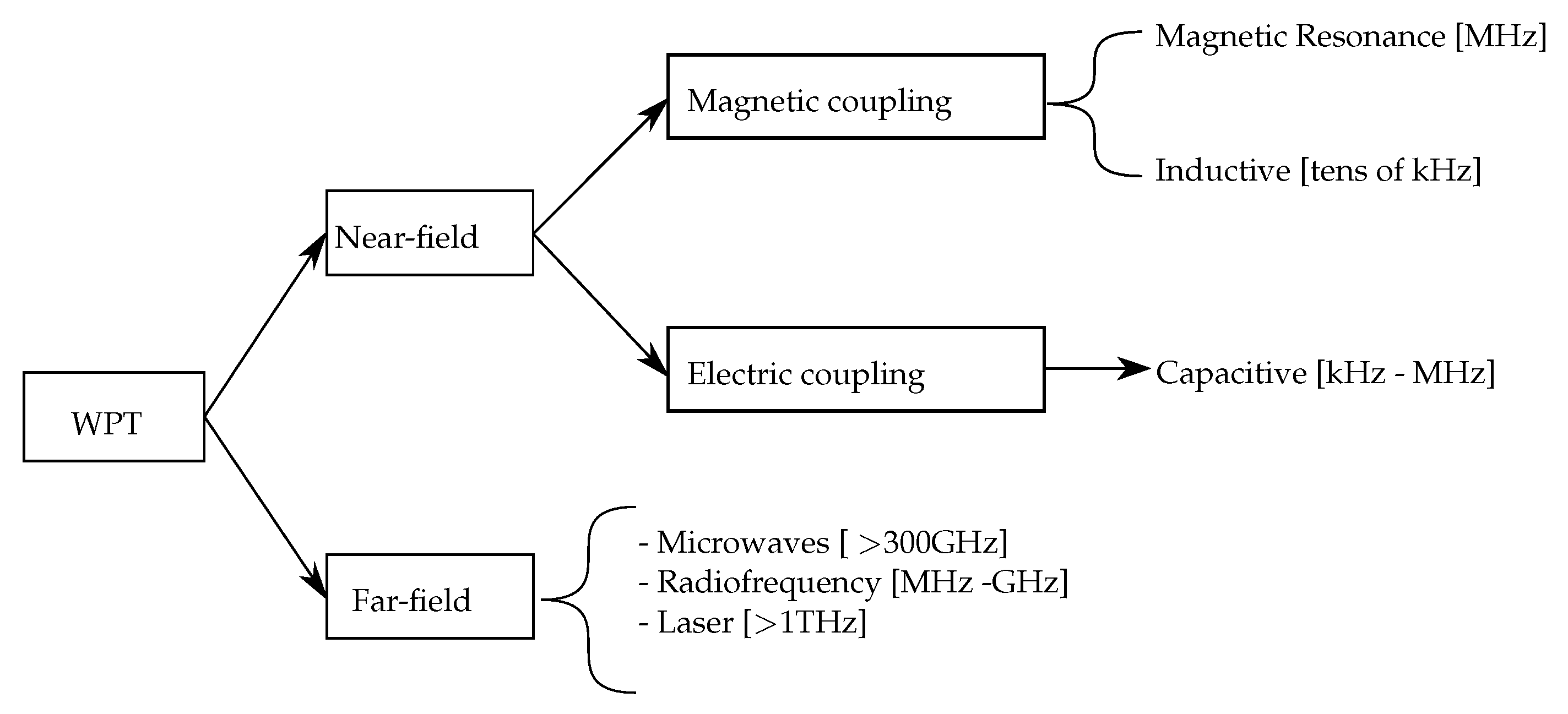





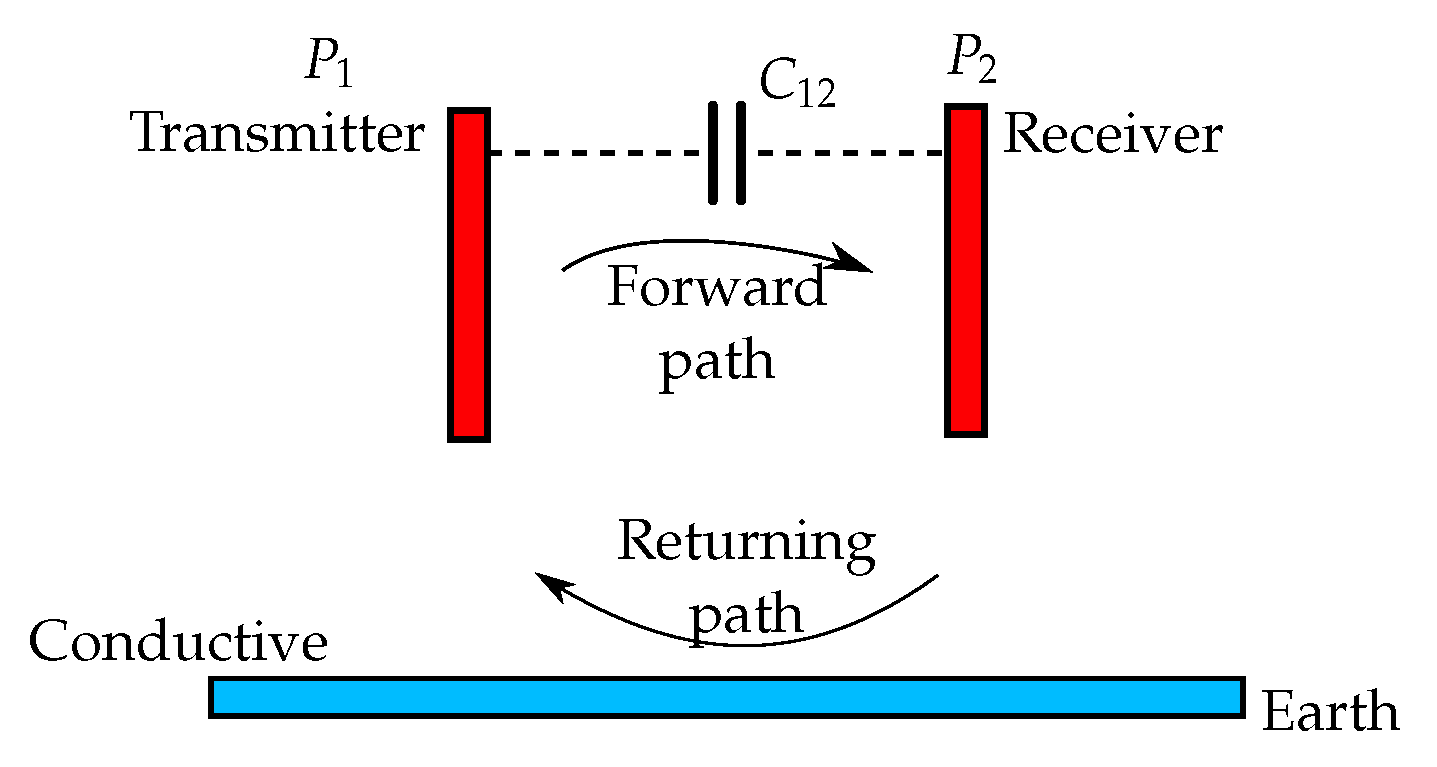

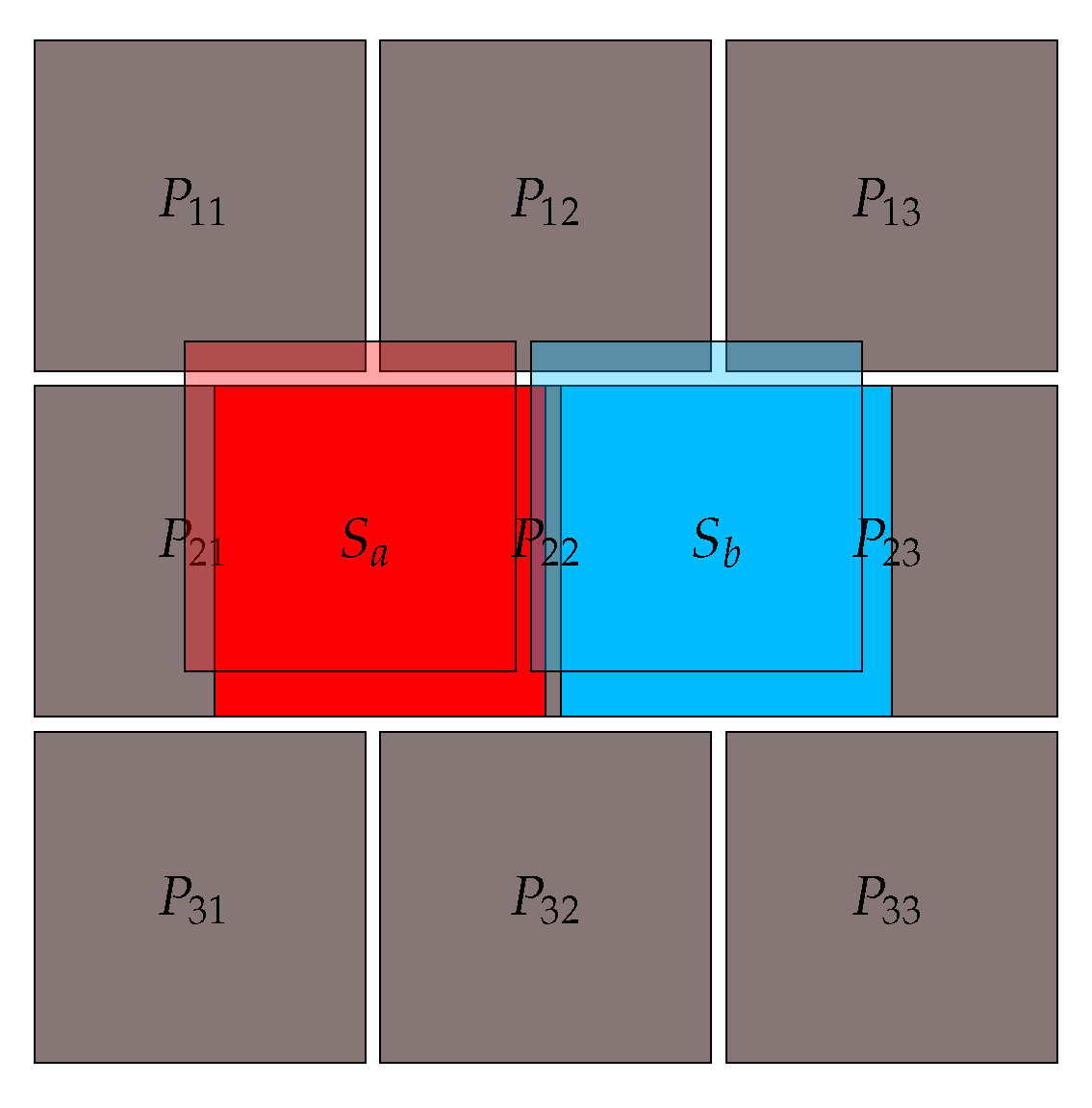
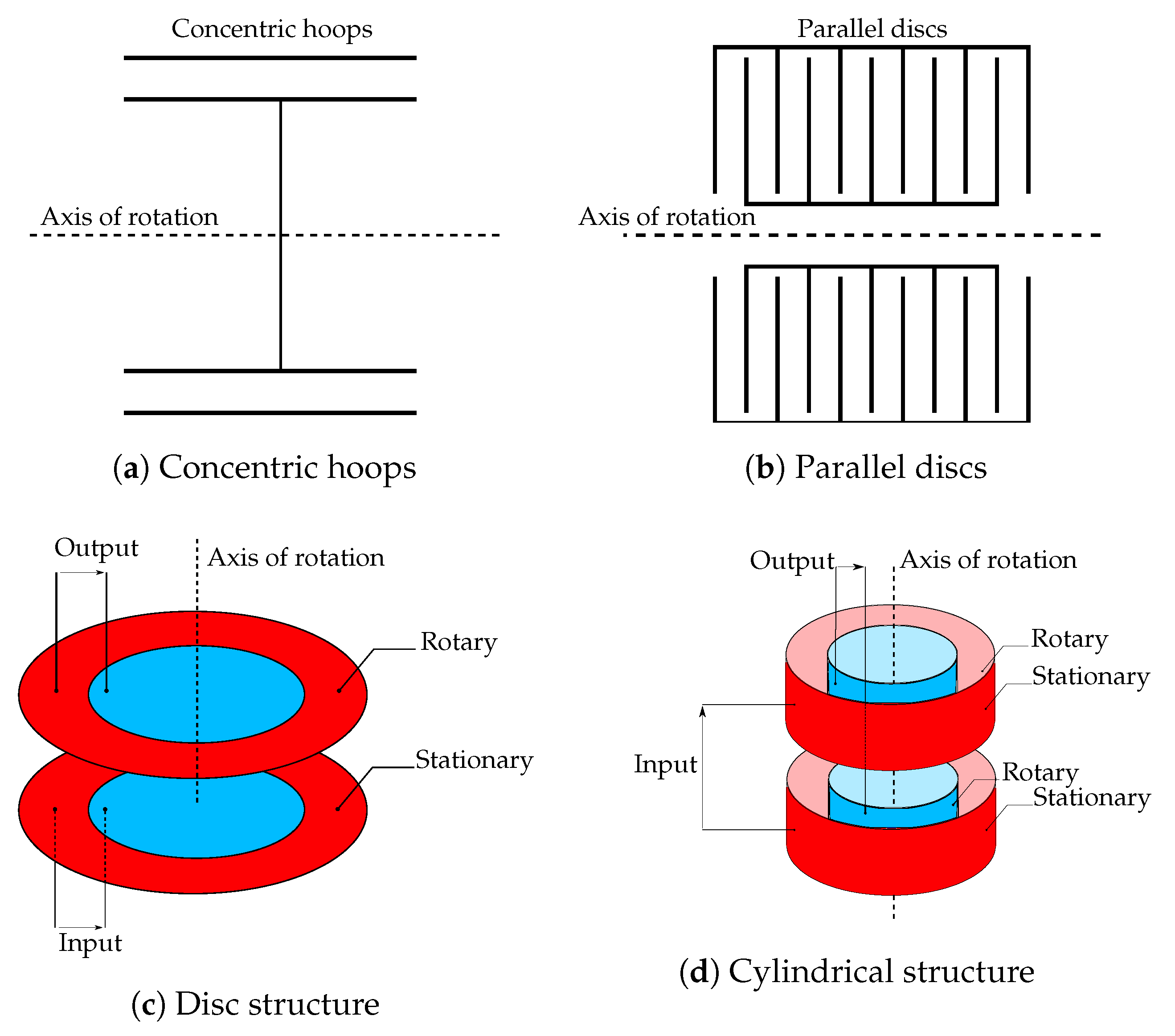

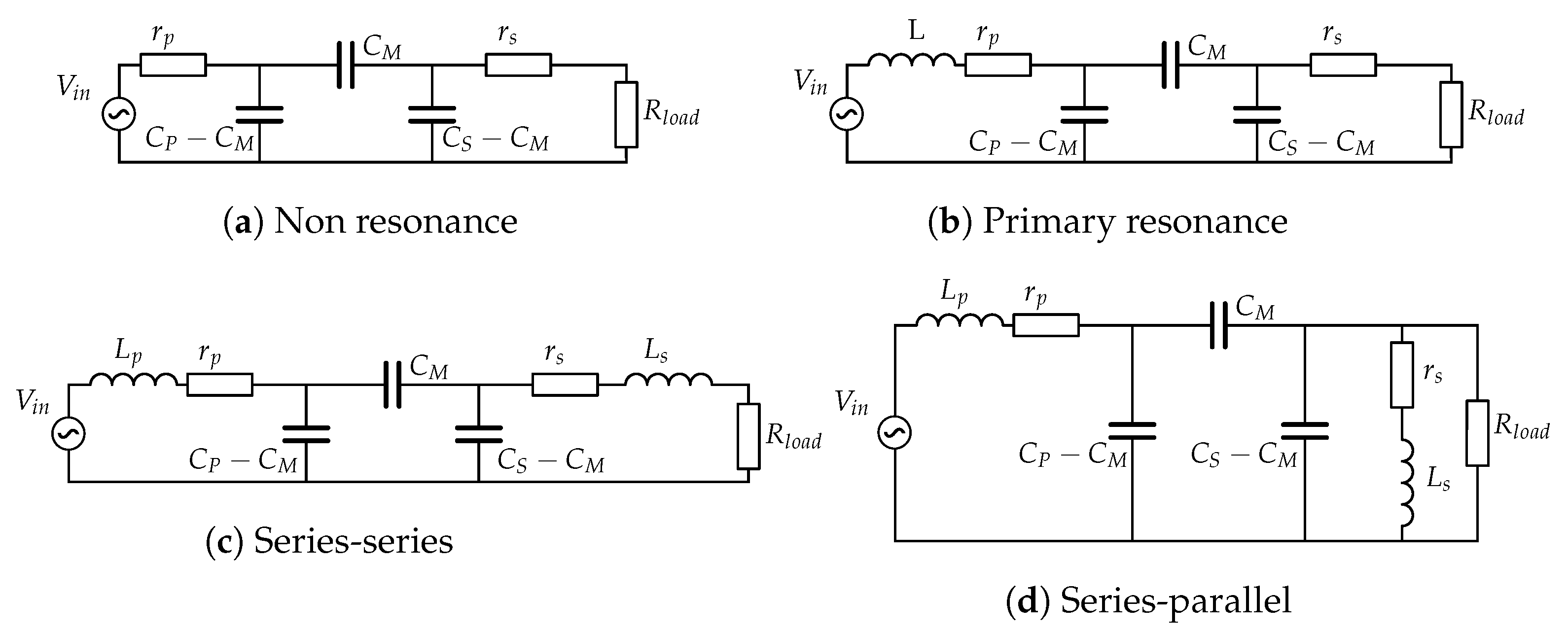


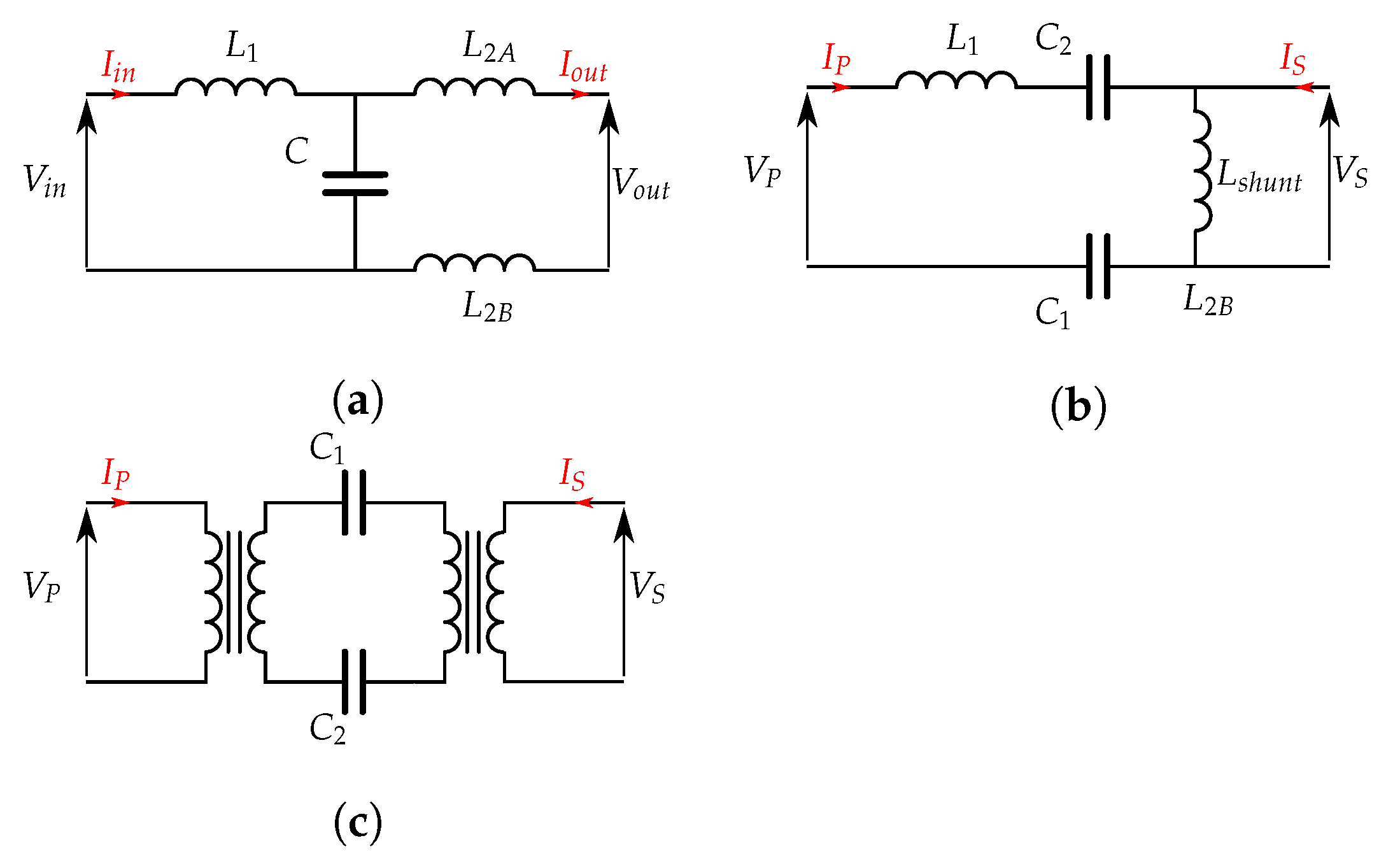
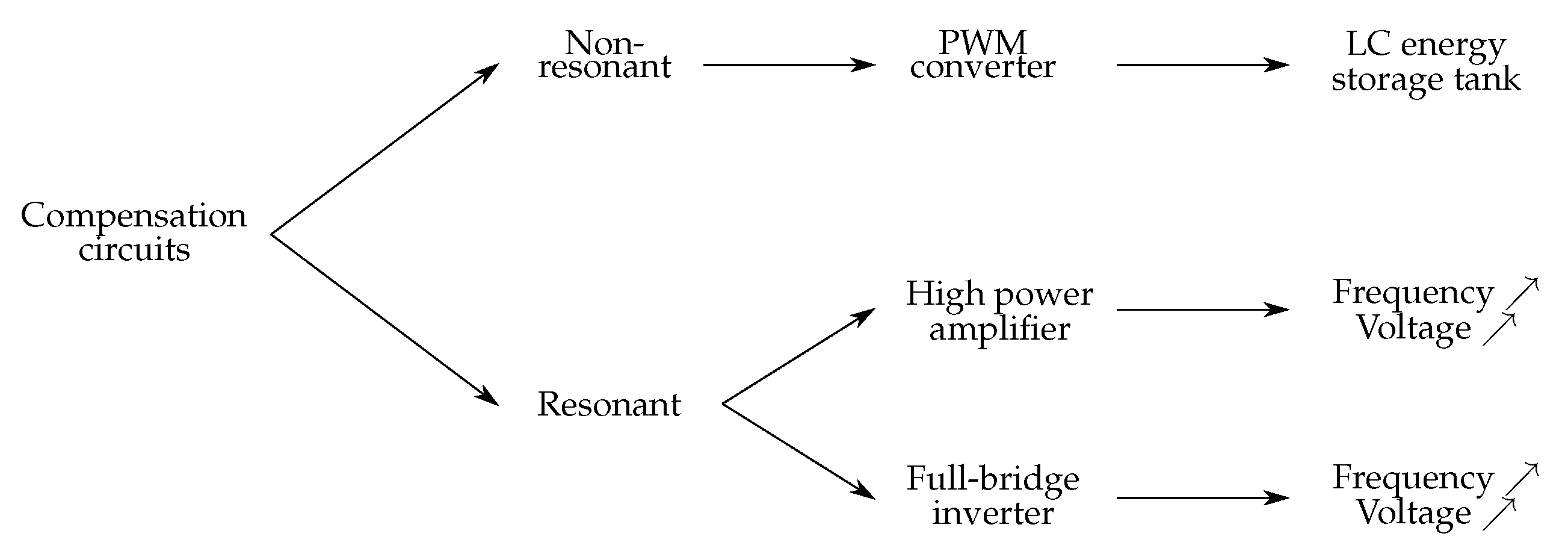
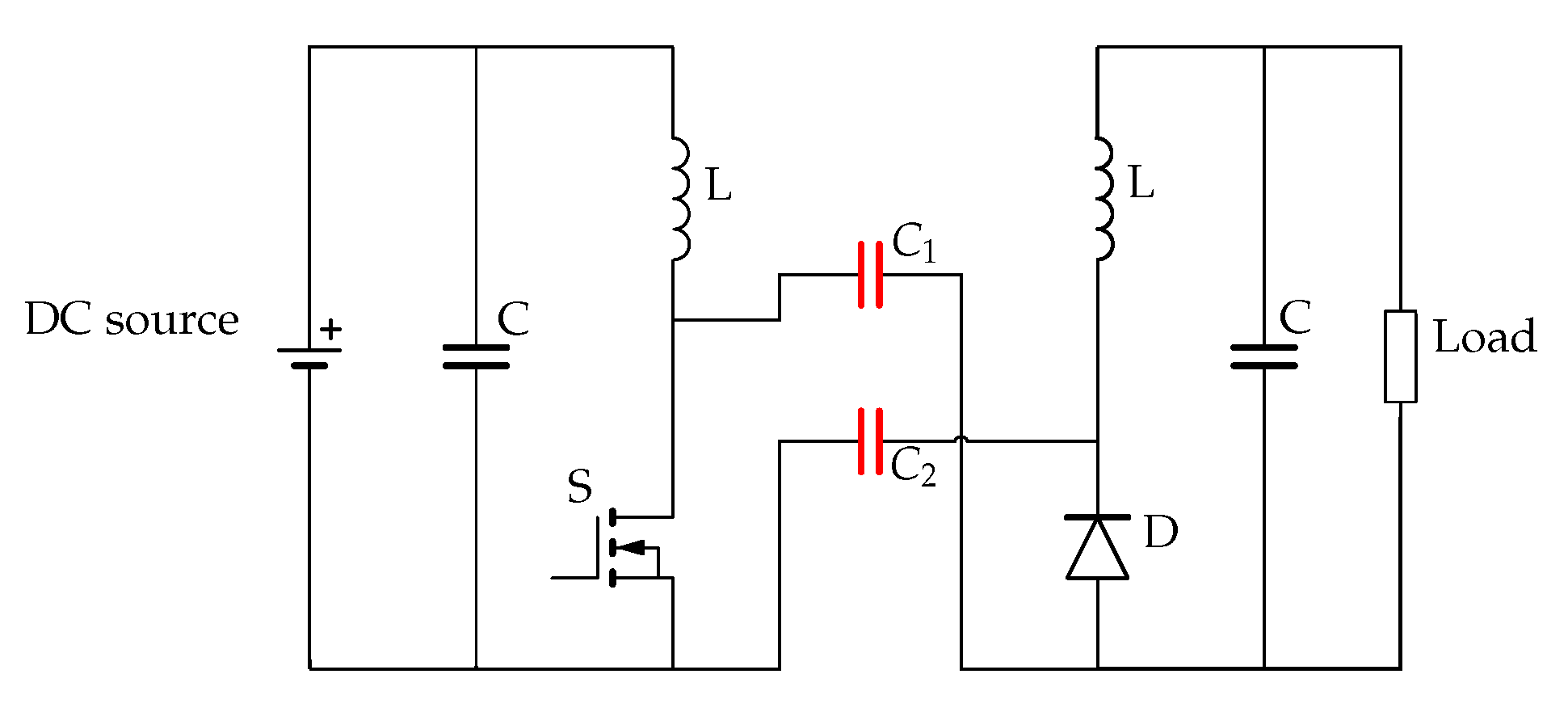


| GPT | IPT | CPT | |
|---|---|---|---|
| Distance | mm—km | mm—5 m [26] | mm—tens of cm |
| Maximum power transfer | GW | 50 kW [27] | 2.4 kW [28] |
| Efficiency | ∼100% | ∼95% | ∼95% |
| Frequency range | DC Hz—GHz | kHz—MHz | kHz—MHz |
| Advantages | •Suitable for any power level •Suitable for a full frequency range •Almost no power losses | •Improved user experience •Robustness & durability •Facilitating miniaturization •Increasing safety •Improved mobility •Design capabilities | •Same advantages as IPT •Power transfer through isolated metal object •Minimal Eddy current losses •Less expensive design than IPT •Less voluminous than IPT •Lower EMI than IPT •Simple configuration for charging multiple receivers |
| Disadvantages | •Disorder •Less design freedom •Less uniform •Less mobile •Maintenance | •Not abundant •Implementation cost •Less efficient •EMI at high power transfer •Efficiency drop with | •Low capacitive coupling •Short distances •High requirements on components •Safety |
| Reference/Year | Improvement | Distance [mm] | Frequency [MHz] | Output Power [W] | Efficiency [%] |
|---|---|---|---|---|---|
| [33]/2008 | New CPT system | 0.22 | 40.5 | 44.3 | |
| [48]/2011 | Matrix plate structure | 0.5 | 0.616 | 2.5 | 51 |
| [28]/2015 | Compensation network | 150 | 1 | 2400 | 90 |
| [49]/2016 | Compensation network | 360 | 1.5 | 105 | 67 |
| [45]/2016 | Compensation network | 10 | 1 | 1.87 | 85.9 |
| [50]/2018 | Six-plate structure | 150 | 1 | 2000 | 91 |
| [39]/2018 | Two-plate structure | 110 | 6.78 | 350 | 74.1 |
| [18]/2018 | CPT in fresh water | 20 | 107.7 | 360 | 90 |
| [51]/2019 | Bidirectional CPT system | 150 | 0.625 | 80 | 80 |
| [30]/2020 | Bidirectional CPT system | 0.25 | 13.56 | 20.5 | 78.8 |
Publisher’s Note: MDPI stays neutral with regard to jurisdictional claims in published maps and institutional affiliations. |
© 2021 by the authors. Licensee MDPI, Basel, Switzerland. This article is an open access article distributed under the terms and conditions of the Creative Commons Attribution (CC BY) license (https://creativecommons.org/licenses/by/4.0/).
Share and Cite
Lecluyse, C.; Minnaert, B.; Kleemann, M. A Review of the Current State of Technology of Capacitive Wireless Power Transfer. Energies 2021, 14, 5862. https://doi.org/10.3390/en14185862
Lecluyse C, Minnaert B, Kleemann M. A Review of the Current State of Technology of Capacitive Wireless Power Transfer. Energies. 2021; 14(18):5862. https://doi.org/10.3390/en14185862
Chicago/Turabian StyleLecluyse, Cédric, Ben Minnaert, and Michael Kleemann. 2021. "A Review of the Current State of Technology of Capacitive Wireless Power Transfer" Energies 14, no. 18: 5862. https://doi.org/10.3390/en14185862
APA StyleLecluyse, C., Minnaert, B., & Kleemann, M. (2021). A Review of the Current State of Technology of Capacitive Wireless Power Transfer. Energies, 14(18), 5862. https://doi.org/10.3390/en14185862







